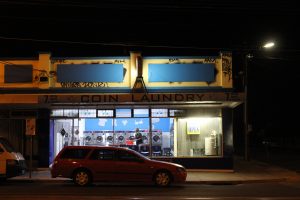Thornbury & the Night Cafe
“Sometimes what’s different is what remains the same”
“The story of the old man and the hipster”
Director’s Statement
It’s a sort of stereotype about Melbourne’s inner north to talk about how ongoing gentrification is removing the vestiges of migrant culture. Undoubtedly this is to some extent true; the number of trendy bars, cafes, hairdressers etc. on traditionally Italian and Greek main streets is clearly evident to anyone who walks through the streets of Brunswick or Northcote or Preston. However, these cultures are far from being erased; these businesses, some odd, some without an obviously profitable business model, persist despite the increase in affluence and (arguably) whiteness in their respective neighbourhoods. Nowhere is this more evident than Thornbury High St, where hipster burger joints share footpath space with Italian pasticcerias and people spill out of bars next door to empty gambling dens.
For this documentary, I want to explore a neighbourhood in a state of flux, but also the parts of it that remain stationary. We focus a lot of attention on what’s different, what’s new, what’s been removed, what’s been forgotten, but I believe an important part of memory is focusing on what is left behind, what is unchanged, and most importantly why it is unchanged. Why are most shops on High St Thornbury transforming into trendy cafes and bars yet businesses that seem less profitable can remain? Are real estate prices not driving them out? Or do they form such an important part of the neighbourhood’s community that they are kept afloat by the people who care for them dearly? I believe by looking at what remains when a neighbourhood undergoes a period of great change can we then begin to answer all of the questions surrounding memory, identity and neighbourhood.
Synopsis
The film will begin by examining the literal structures and buildings that house the businesses of High St Thornbury. I believe by looking at these places and structures we can see their history, what preceded them, how long they have been there, and even draw a distinction between newer businesses and those who have been there for a long time. I want the viewer to be able to intuit and understand this through having a knowledge of the physical Thornbury.
From here, we will continue to an intermixed series of interviews with and meditations on the various businesses of High St Thornbury. Business owners, employees and their customers will talk about how their business fits into the locale, what they know and remember about the area and how they’ve seen the area change, depending on how long they’ve been there. The viewer will also gain an insight into the businesses’ practices: what these employees and owners occupy themselves with all day, the coming and going of customers, how foot traffic and trade changes and evolve throughout the day as Thornbury turns from a shopping strip into a centre of nightlife.
Finally, we will cast our gaze on the infamous Night Cafe, which throughout the last two segments will stand in as a symbol for all of the old-style businesses that remain on the street. The various residents of Thornbury will talk about their knowledge and experience of the Night Cafe. Although I’m open to talking to some customers, I want the Night Cafe to remain somewhat obscured; I believe it’s more interesting to talk about how it is perceived by the rest of the neighbourhood, how things are strangely repulsed by it yet simultaneously revolve around it. The Night Cafe’s persistence in the neighbourhood will hopefully answer some of the questions I have set up in my statement.
Method – Potential Interview Subjects
Here are some businesses and (in some cases) their proprietors who I think could make interesting interview subjects:
Perimeter Books
Perimeter is a brick-and-mortar bookstore, distributor and independent publisher based in a small shopfront on High St, specialising in art, architecture and design books. The owners Dan and Justine are a nice, fairly young couple very respected in the art book world in Melbourne. Their shop has been their for quite a few years, I believe just before the full gentrification of the strip began.
Carwyn Cellars
This bottleshop-cum-bar has become a hub in the area for anyone looking for specialised alcohol or a quick, microbrewed pint after work, and is always very busy, especially on the weekend. It’s had its current owners since 2007 so has seen the area change quite a bit in that time period.
Umberto’s
An old-style Italian bar and bistro with delicious, excellently priced food. It’s been on the strip for a very very long time but has adapted into a restaurant that, although pokey, has excellent service and is massively popular.
Thornbury Theatre
One of the oldest institutions and businesses on the strip, the Thornbury Theatre is rumoured to be undergoing another change from ballroom to cinema. This place has adapted so many times over the years, it would be great to see the proprietor’s attitude to the changing strip.
Monticello Cakes
An old-style Italian pasticceria that has bee on the strip for a very long time, and also situated right next door to the infamous Night Cafe. The owners, presumably Italian background, would have a lot to say about the gentrification of the neighbourhood.
Shooting Style
The interviews will be conducted in a traditional documentary style subject interview, with the subject responding to unseen and unheard questions from the documentary filmmaker. However, I want to frame the subjects in their businesses: a bookseller surrounded by the books he sells and publishes, a pastry chef surrounded by her sweets, a bartender surrounded by his craft beers and boutique wines. For the rest of the film/b-roll, I will focus on capturing the aesthetic qualities of buildings and what they can tell us about the neighbourhood’s memory and history.





